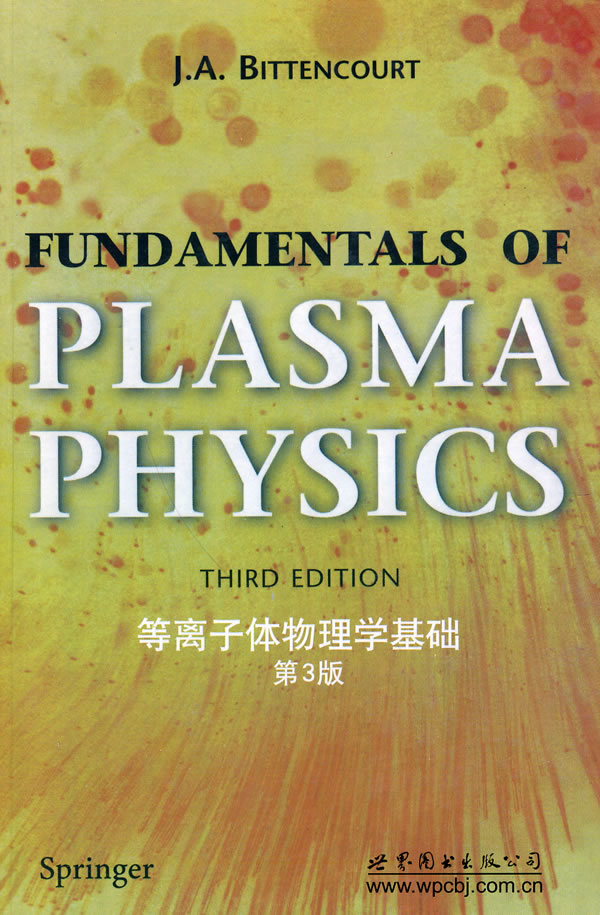- ISBN:9787510005596
- 装帧:一般胶版纸
- 册数:暂无
- 重量:暂无
- 开本:24开
- 页数:678
- 出版时间:2010-04-01
- 条形码:9787510005596 ; 978-7-5100-0559-6
本书特色
《等离子体物理学基础(第3版)(英文版)》是由世界图书出版公司出版的。
内容简介
本书系统地介绍了等离子体物理学的基本理论及其在很多重要等离子体现象中的应用。本书内容全面,结构合理,阐述清晰。作者注重表达的简洁性,没有拘泥于形式,对自学和进阶很有好处。从统计动力学讨论等离子体现象是本书的一大特色。另外,作者对数学处理技巧说明得非常详细,列举了数学推导的中间步骤,这些通常是留给读者自己完成的,同时强调了这些公式的物理解释,帮助读者获得更深入的理解。书中设计的习题是内容的重要组成部分,也是进一步提高的出发点。阅读本书需要经典力学和电动力学的基本知识。
本书适合于初次学习等离子体物理的高年级本科生和一年级研究生,同时也适用于对等离子体现象以及相关领域诸如空间物理和应用电磁学等感兴趣的研究人员。目次:简介;稳恒和均匀电磁场中的带电粒子运动;非均匀静磁场中的带电粒子运动;随时间变化的电磁场中的带电粒子运动;等离子体动力学理论基础;平均值和宏观变量;平衡态;宏观输运方程;导电流体的宏观方程;等离子体电导率和扩散;若干基本等离子体现象;磁流体动力学的简单应用;缩聚效应;自由空间电磁波;磁流体动力学波;冷等离子体波;暖等离子体波;热各向同性等离子体波;热磁化等离子体波;等离子体中粒子间相互作用;波尔兹曼和佛克尔—普朗克方程;等离子体中的输运过程;附录a:常用的矢量关系;附录b:迪卡尔坐标和曲线坐标中的常用关系;附录c:物理常数:附录d:物理单位间的换算因子;附录e:部分重要的等离子体参数;附录f:若干典型等离子体的近似量极;索引。
读者对象:物理,化学和材料专业的高年级本科生、研究生和相关专业的科研人员。
目录
1.introduction
1.general properties of plasmas
2.criteria for the definition of a plasma
3.the occurrence of plasmas in nature
4.applications of plasma physics
5.theoretical description of plasma phenomena
problems
2.charged partie motion in constant and uniform uniform electromagnetic fields
1.introduction
2.energy conservation
3.uniform electrostatic field
4.uniform magnetostatic field
5.uniform electrostatic and magnetostatic fields
6.drift due to an external force
problems
3.charged particle motion in nonuniform magnetostatia fields
1.introduction
2.spatial variation of the magnetic field
3.equation of motionin the first-order approximation
4.average force over one gyration period
5.gradient drift
6.parallel acceleration of the guiding center
7.curvature drift
8.combined gradient-curvature drift
problems
4.charged particle motion in time-varying electromagnetic fields
1.introduction
2.slowly time-varying electric field
3.electric field with arbitrary time variation
4.time-varying magnetic field and space-varying electric field
5.summary of guiding center drifts and current densities
problems
5.elements of plasma kinetic theory
1.introduction
2.phase space
3.distribution function
4.number density and average velocity
5.the boltzmann equation
6.relaxation model for the collision term
7.the vlasov equation
problems
6.average values and macroscopic variables
1.average value of a physical quantity
2.average velocity and peculiar velocity
3.flux
4.particle current density
5.momentum flow dyad or tensor
6.pressure dyad or tensor
7.heat flow vector
8.heat flow triad
9.total energy flux triad
10.higher moments of the distribution function
problems
7.the equilibrium state
1.the equilibrium state distribution function
2.the most probable distribution
3.mixture of various particle species
4.properties of the maxwell-boltzmann distribution function
5.equilibrium in the presence of an external force
6.degree of ionization in equilibrium and the saha equation
problems
8.macroscopic transpsrt equations
1.moments of the boltzmann equation
2.general transport equation
3.conservation of mass
4.conservation of momentum
conservation of energy
6.the cold plasma model
7.the warm plasma model
problems
1.macroscopic variables for a plasma as a conducting fluid
2.continuity equation
3.equation of motion
4.energy equation
5.elect rodynamic equations for a conducting fluid
6.simplified magnetohydrodynamic equations
problems
1.introduction
2.the langevin equation
3.linearization of the langevin equation
4.dc conductivity and electron mobility
5.ac conductivity and electron mobility
6.conductivity with ion motion
7.plasma as a dielectric medium
8. free electron diffusion
9.electron diffusion in a magnetic field
10.ambipolar diffusion
11.diffusion in a fully ionized plasma
problems
1.electron plasma oscillations
2.the debye shielding problem
3.debye shielding using the vlasov equation
4.plasma sheath
5.plasma probe
problems
1.fundamental equations of magnetohydrodynamics
2.magnetic viscosity and reynolds number
3.diffusion of magnetic field lines
4.freezing of magnetic field lines to the plasma
5.magnetic pressure
6.isobaric surfaces
7.plasma confinement in a magnetic field problems
14.wlwctromagnetic waves in free space
1.introduction
2.the equilibrium pinch
3.the bennett pinch
4.dynamic model of the pinch
5.instabilities in a pinched plasma column
6.the sausage instability
7.the kink instability
8.convex field configurations
problems
15.magnetohydrodynamic waves
1.the wave equation
2.solution in plane waves
3.harmonic waves
4.polarization
5.energy flow
6.wave packets and group velocity
problems
16.waves in cold plasmas
1.introduction
2.mhd equations for a compressible
3.propagation perpendicular to the magnetic field
4.propagation parallel to the magnetic field
5.propagation at arbitrary directions
6.effect of displacement current
7.damping of mhd waves problems
5.wave propagation in magnetized cold plasmas
6.propagation parallel to bo
7.propagation perpendicular to bo
8.propagation at arbitrary directions
9.some special wave phenomena in cold plasmas
problems
17.wsves in warm plasmas
1.introduction
2.waves in a fully ionized isotropic warm plasma
3.basic equations for waves in a warm magnetoplasma
4.waves in a warm electron gas in a magnetic field
5.waves in a fully ionized warm magnetoplasma
6.summary
problems
18.wsves in hot isotropic plasman
1.introduction
2.basic equations
3.general results for a plane wave
4.electrostatic longitudinal wave in a hot isotropic plasma
5.transverse wave in a hot isotropic plasma
6.the two-stream instability
7.summary
problems
19.waves in hot magnetized plasmas
1.introduction
2.wave propagation along the magnetostatic field in a hot plasma
3.wave propagation across the magnetostatic field in a hot plasma
4.summary
problems
20.particle interactions in plasmas
1.introduction
2.binary collisions
3.dynamics of binary collisions
4.evaluation of the scattering angle
5.cross sections
6.cross sections for the hard sphere model
7.cross sections for the coulomb potential
8.screening of the coulomb potential
problems
21.the bol tzmann and the fokker-planck equations
1.introduction
2.the boltzmann equation
3.the boltzmann's h function
4.boltzmann collision term for a weakly ionized plasma
5.the fokker-planck equation
problems
22.tpansport processes in plasmas
1.introduction
2.electric conductivity in a nonmagnetized plasma
3.electric conductivity in a magnetized plasma
4.free diffusion
5.diffusion in a magnetic field
6.heat flow
problems
appendix a
useful vector relations
appendix b
useful relations in cartesian and
in curvilinear coordinates
appendix c
physical constants (mksa)
appendix d
conversion factors for physical units
appendix e
some important plasma parameters
appendix f
approximate magnitudes in some typical plasmas
index
节选
《等离子体物理学基础(第3版)(英文版)》系统地介绍了等离子体物理学的基本理论及其在很多重要等离子体现象中的应用。《等离子体物理学基础(第3版)(英文版)》内容全面,结构合理,阐述清晰。作者注重表达的简洁性,没有拘泥于形式,对自学和进阶很有好处。从统计动力学讨论等离子体现象是《等离子体物理学基础(第3版)(英文版)》的一大特色。另外,作者对数学处理技巧说明得非常详细,列举了数学推导的中间步骤,这些通常是留给读者自己完成的,同时强调了这些公式的物理解释,帮助读者获得更深入的理解。书中设计的习题是内容的重要组成部分,也是进一步提高的出发点。阅读《等离子体物理学基础(第3版)(英文版)》需要经典力学和电动力学的基本知识。《等离子体物理学基础(第3版)(英文版)》适合于初次学习等离子体物理的高年级本科生和一年级研究生,同时也适用于对等离子体现象以及相关领域诸如空间物理和应用电磁学等感兴趣的研究人员。目次:简介;稳恒和均匀电磁场中的带电粒子运动;非均匀静磁场中的带电粒子运动;随时间变化的电磁场中的带电粒子运动;等离子体动力学理论基础;平均值和宏观变量;平衡态;宏观输运方程;导电流体的宏观方程;等离子体电导率和扩散;若干基本等离子体现象;磁流体动力学的简单应用;缩聚效应;自由空间电磁波;磁流体动力学波;冷等离子体波;暖等离子体波;热各向同性等离子体波;热磁化等离子体波;等离子体中粒子间相互作用;波尔兹曼和佛克尔—普朗克方程;等离子体中的输运过程;附录A:常用的矢量关系;附录B:迪卡尔坐标和曲线坐标中的常用关系;附录C:物理常数:附录D:物理单位间的换算因子;附录出部分重要的等离子体参数;附录F:若干典型等离子体的近似量极;索引。读者对象:物理,化学和材料专业的高年级本科生、研究生和相关专业的科研人员。
-

13次时空穿梭之旅
¥18.7¥59.0 -

勒维特之星-大发现系列丛书
¥5.0¥16.0 -

递归求解
¥9.4¥28.0 -

核科学基本原理
¥14.5¥39.8 -

技术史入门
¥15.4¥48.0 -

天文学卷-异想天开-古今中外天文简史-《中国大百科全书》普及版
¥6.1¥19.0 -

科学哲学——科学家的视角
¥43.9¥78.0 -

发现之旅数的王国——世界共通的语言
¥41.1¥68.0 -

声音简史
¥23.9¥52.0 -

青少年及成.人普林斯顿数学分析读本
¥43.1¥69.0 -

130种美鸟彩图馆
¥15.3¥39.8 -

疯狂实验史-II
¥23.7¥36.0 -

北宋科技思想研究纲要
¥9.8¥26.0 -

概率统计
¥5.7¥11.0 -

新科学时代的思考
¥46.2¥78.0 -

智慧宫029梦游者:西方宇宙观念的变迁
¥75.5¥128.0 -

现代生物特征识别技术
¥34.8¥49.0 -

羌塘盆地构造演化与油气生成和保存
¥229.0¥318.0 -

普林斯顿微积分简析
¥42.3¥55.0 -

概率论与数理统计辅导讲义 基础强化一本通
¥44.4¥70.0














